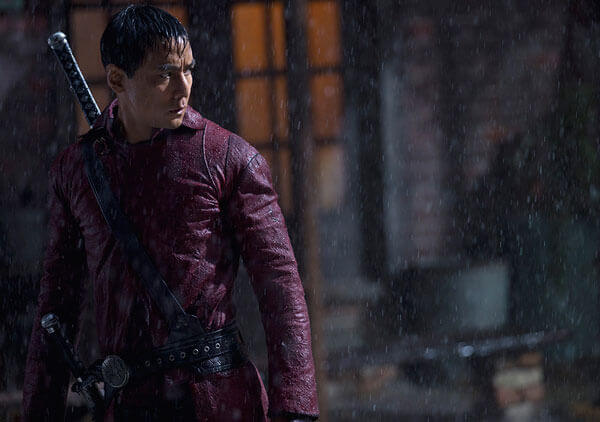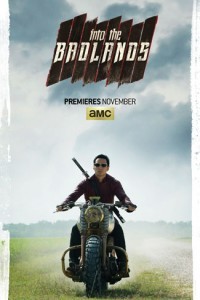
AMC’s set to premiere season one of Into the Badlands, an action series that will reintroduce martial arts to television, on Sunday, November 15, 2015 at 10pm ET/PT. Starring Daniel Wu, Aramis Knight, Emily Beecham, and Marton Csokas, Into the Badlands is set in a future world in which seven feudal Barons control all of the resources. Wu plays a ruthless warrior, and Knight is a young boy who teams up with the warrior to embark on a spiritual journey in this very dangerous world.
Joining Wu and Knight to do press roundtables at Comic-Con was executive producer/director David Dobkin, and together they provided a look behind the scenes at Into the Badlands.
Daniel Wu, Aramis Knight, and David Dobkin Interview
Where is the show set? What can you say about the premise?
David Dobkin: “It is set somewhere in America, sometime in the future. It is a historic future. Actually, it’s easier when the writers are at the table because then you know what you can say and what you really can’t say. Yeah, it’s post great extinction. Society was chaotic for a while, probably nomadic. Finally a few people put together armies to protect the few. The world has seven barons that each sit on a critical natural resource and they each control one. They all work in cahoots but it’s basically a very violent, very brutal world where there’s no guns. There are just martial arts armies. There’s no inheritance like a king would pass down bloodlines. None of that exists. It’s basically dog eat dog and whoever can get to the top of the hill survives.”
You’re also bringing back the old Wuxia style?
Daniel Wu: “I think there’s also a very clever way that Al [Gough] and Miles [Millar] gave me the reason for why there are no guns in the battles. I don’t think I can say why, but they have a very good reason because when we were shooting, let’s say, contemporary pieces, it’s like we always have to find good reasons why they’re fighting with swords and bare hands and not with guns. I think you had the same problem in Shanghai Knights, right?”
David Dobkin: “We did, because as soon as someone pulls a gun, there’s no reason to actually fight. So they created a world that actually very organically addresses that.”
How many styles of martial arts are there in the world of this series?
David Dobkin: “It’s infinite.”
Aramis Knight: “I mean, every martial artist has a different style.”
Daniel Wu: “We have Chinese Kung Fu. We have Krav Maga. We have a little bit of Jiu Jistu, Ninjutsu, Muay Thai.”
David Dobkin: “So basically we drew from elements of the martial arts genre that we liked and kind of made our own mashup of it. So it’s a mix of styles trying to create a new, dynamic style, something that’s fresh and new for American television because you definitely haven’t seen this kind of fighting on American television before. So we really wanted to up that game and try to not just stick with one style, but use whatever is dynamic with any martial arts style. In that way, it’s kind of like Bruce Lee’s martial arts philosophy which is, ‘Don’t stick to one thing. Do what works best for you. Use what works best for you.’ In this case, we’re doing that stylistically as well for the fighting action.”
Why do you think there hasn’t been a martial arts show on television in years?
Daniel Wu: “It’s very expensive.”
David Dobkin: “It’s very difficult to make and expensive.”
Daniel Wu: “The truth is in order to do it right, do it the way that these guys do it, it takes a lot of time. And in America, shoot days are too expensive to do it the Hong Kong style. But we’ve kind of designed a way of doing that and it’s not without its expense. But this is the first time anyone’s ever tried to actually do it and mount it successfully for television like this. You’ve never seen anything like it on TV, for sure.”
Aramis Knight: “It definitely takes a specific type of team. We work two units. We have a main unit which is for all the theatrics, for all the drama, and then a fight unit for all the martial arts. Both of them sort of intertwine in certain ways. We have to work around each other and at the end of the day still come together as one whole project.”
Can you talk about the filming style? Are there parts that look like a comic book? Did you choose a specific color palette?
David Dobkin: “The color palette relates to, especially with the costumes, relates to the different groups. So our baron, Quinn, is the Armadillos. They will wear sort of crimson color. The Widow is the Butterflies and they have this aqua blue marine color. And those are just sort of helping to differentiate the different groups and their barons and how they interact with each other.”
How did you prepare for your role?
Daniel Wu: “Well, we had a fight camp for the actors that had no martial arts experience before and it was a six week fight camp with D.D. and Stephen [Fung], first of all assessing what they could do because people have natural abilities, natural talents. Like Aramis is naturally athletic. So we figured out what we can use of his natural abilities that would help in the fighting scenes.
And then also teach him new things as well. You cannot become a martial arts expert in six weeks, but what we can do is pick and choose the best of what these people have naturally and accentuate those or make it better. But then also to teach them basics as well, basic roundhouse kick, all this stuff they didn’t know as well.
For me myself, I hadn’t done a martial arts action piece in a long time, like eight years or something like that. So I started preparing probably as early as August because I’m older than him. So it takes a little while to make sure…and I also had serious injuries. I’ve torn an ACL, I’ve broken an ankle. So for me it was a slower process at the beginning and then I ramped it up at the end once I knew my body was handling it well. That’s basically it is training hours. Fight camp was from 9 to 6 every day, 9 in the morning to 6 at night.”
What is the emotional core of the story?
David Dobkin: “I think the emotional core of the story is about, it starts with there’s a boy who’s trying to find his way home. And there’s a man who has never had a home, but he’s slowly discovering, Quinn, this man who was not his real father but a father that saved him and brought him up, trained him to be the man that he is today. It’s discovering that your father is a horrible man and trying to understand how you get out from underneath that when there’s not really an escape.
It’s a little bit like being in a gangster movie where you discover, ‘Hey man, I want to get out now,’ and nobody leaves. So that dynamic is there and together I think they end up on a journey to enlightenment.
We always think of all of this through the terms of the great Chinese epic storytelling. The fact that he’s carrying the burden of all the people that he’s killed and how does he move forward from that? He’s starting to be effective and carry the weight of that. He’s having an awakening already at the beginning of the show. This boy walks in who’s very pure and has a very simple emotional journey and he can’t stand to see that boy’s journey not continue. And he also realizes that the boy may be his chance to get out. So it’s beautiful because the lines are very simple, but I think of a movie like Shane or any of the great Westerns. It has all those very, very simple elements of character to it.”
How quickly will be introduced to Veil (played by Madeleine Mantock) and Sunny’s relationship?
David Dobkin: “In the first episode, we’re introduced to it because his emotional core is built around her actually.”
Can you talk more about the different color palettes and different barons, and will it be similar to the approach of Game of Thrones?
David Dobkin: “I love that you point that out. We don’t have the extremities that they have as far as they have snow. They have Italy or wherever they’re shooting that stuff, Malta, huge castles and stuff. We have a world that’s much less populated and sparse and just finding its way back onto its feet as a civilization. But I think that the color palette to be able to identify people, especially when you start to see from a base place, when armies start fighting, you need to identify who’s who.
And I also like the fact that the characters each have colors that are kind of specific to themselves and you can identify them. But we hope we imbue the kind of feeling that you get in a show like Game of Thrones. When you cut to The Watch, you feel a certain way. When you cut to Westeros, you feel totally different.
We have that element in a smaller scale. Like our fort where Quinn is at, it has a specific feel, a specific color. Then when you go to The Widow’s lodge, it’s totally has a different name, The Lodge, because The Fort has a masculine feeling. You go to her place and there’s this sophisticated element. There’s books around. There’s art around. There’s things like that that represent her character and what she’s about, what she’s trying to imbue upon her followers.”
Aramis Knight: “It might feel a bit more rural than The Fort really just because The Fort is the biggest. Quinn is the most powerful baron in the badlands. He’s the biggest baron in the badlands so he overlooks everything and controls so much, not only in The Fort but also just in the badlands in general. I think it’s going to be interesting to see The Lodge, there’s more freedom of speech and it’s less organized government I guess that Quinn has really created with The Fort.”
David Dobkin: “Widow’s introducing new ideas. She’s the first female baron and she trains girls to fight. There are things that she’s doing that are really revolutionary but like any person at the forefront of a bunch of ideas, it’s very extreme and it has a lack of humanity to it as well. It’s very brutal because she’s trying to win this idea through. But it’s fascinating how much depth and detail these guys have dreamt up and put into the show. It’s a very complete world. That’s very, very hard to find. Unless you’re coming out of a novel, it’s very hard to find a world that’s been this well thought out.”
More on Into the Badlands: Into the Badlands Interview with Al Gough, Miles Millar, Marton Csokas, Emily Beecham and Orla Brady Interview






